Frost giant Friday!
Frost giant Friday!
Happy Wednesday everybody! I hope it finds you well.
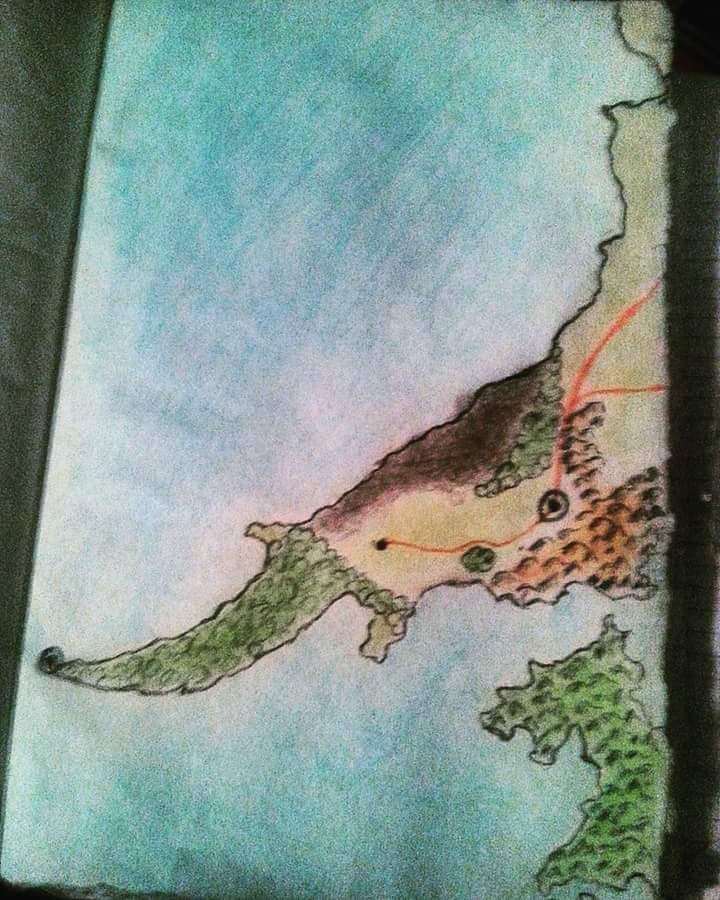
Referral giveaway update time, just as a reminder that it is still going on.
To sum up for those of you who haven’t read about it a previous update(about a month or so I think): if Exile, Magus reaches funded status, then I will go through the list of those who have referred the book. Anyone who has also ordered at least 1 copy of Magus themselves(ebook or physical) will have 3 added to their effective total.
The 10 people with the highest effective totals will then be contacted to claim an item from the giveaway pool in order from highest to lowest referrals. In the case of a tie the person who ordered their copy of Magus first will be chosen. Currently I’m in the lead of referrals, but since I’m obviously not eligible that doesn’t matter. First place is only ahead by 1 referral, and 2nd place is something like a 20 way tie last I checked, so it would be easy for anyone to move up the ranks as it were.
Any items in the giveaway pool after the referral portion is decided will then move to a giveaway pool just for those of you who were kind enough to order the book. As I’m trying to add as many items for giveaway as I can, I’m not sure how many items will be left over. If Magus funds I’ll divide everyone who has ordered up as evenly as possible chronologically and roll off(because I love rolling dice) for the remaining prizes. So, for example, if we only hit 250 orders and there were 10 items left over from the referral giveaway, then there would be 10 lists of 25 orders each which I would roll on.
The items currently available for giveaway are:
So as it currently stands there are 21 items available which means 11 would be left over after the referral contest. I’m hoping to scrape together enough money to fund at least 1 more piece of art before this campaign is over, and since I make it a point to get 3 signed prints with each commission that would up the total pool to 24.
As a reminder though, Magus does need to fund before these giveaways happen. As much as I wish I could just do giveaways without regards to funding status, I can’t for practical reasons. Put simply, I plan to get this book out, and while I really do hope this can be done through Inkshares, if it can’t then I’ll likely be going the self-publishing route. If I go the self-publishing route I’ll like have to crowdfund at least a portion of that, and I’ll need the items currently available as part of any crowdfunding effort since my budget couldn’t really support giving them away twice.
The art mentioned above is all viewable on my page, but I’ll also be posting it below. You can check out a bit about "Children of the Wise Oak" on its Amazon page here.
Thanks to everyone for your time and support! Enjoy your weekend, and the art to follow!
Calden Family Crest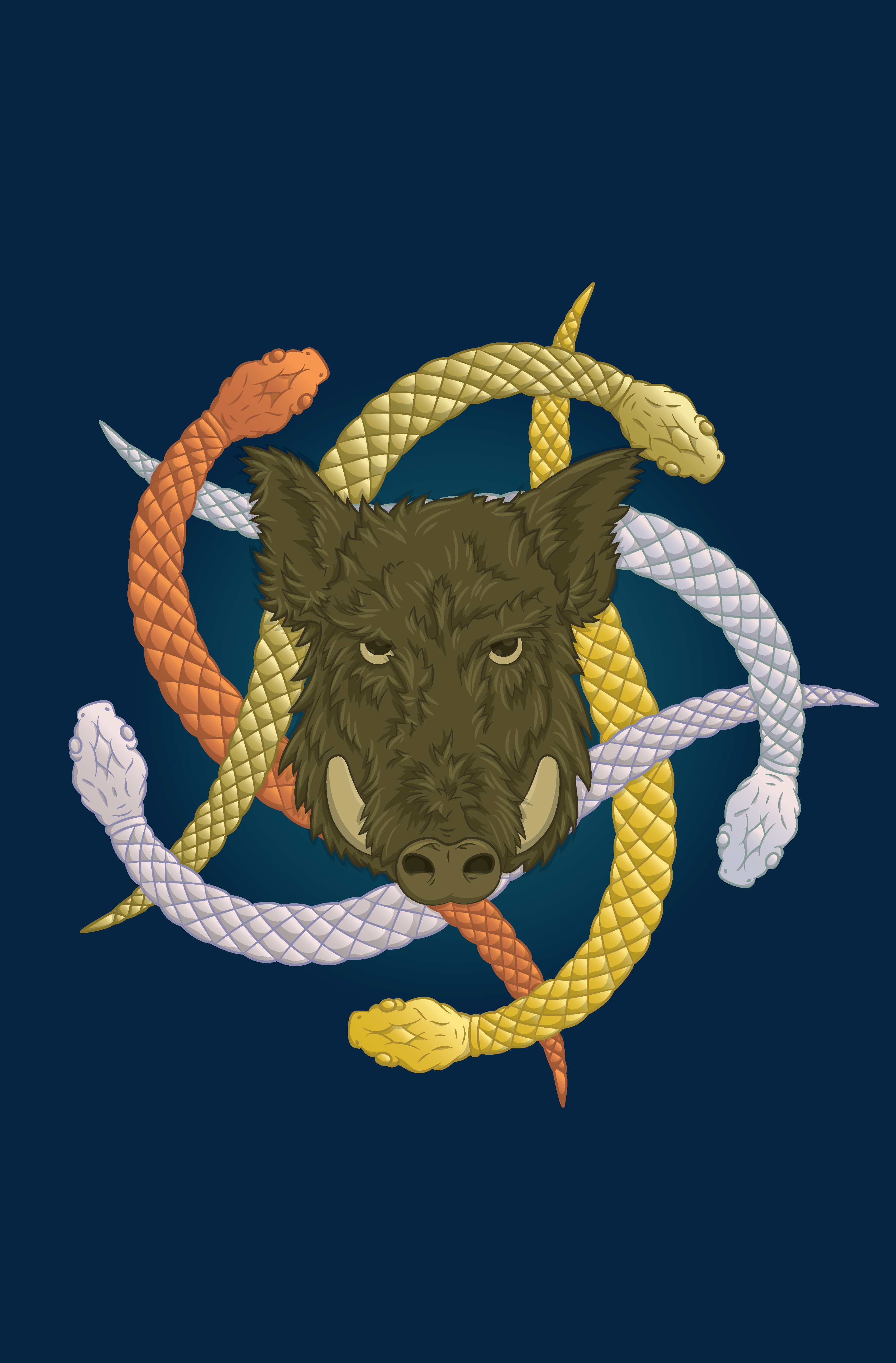
Buscidia vs. the Cog Monster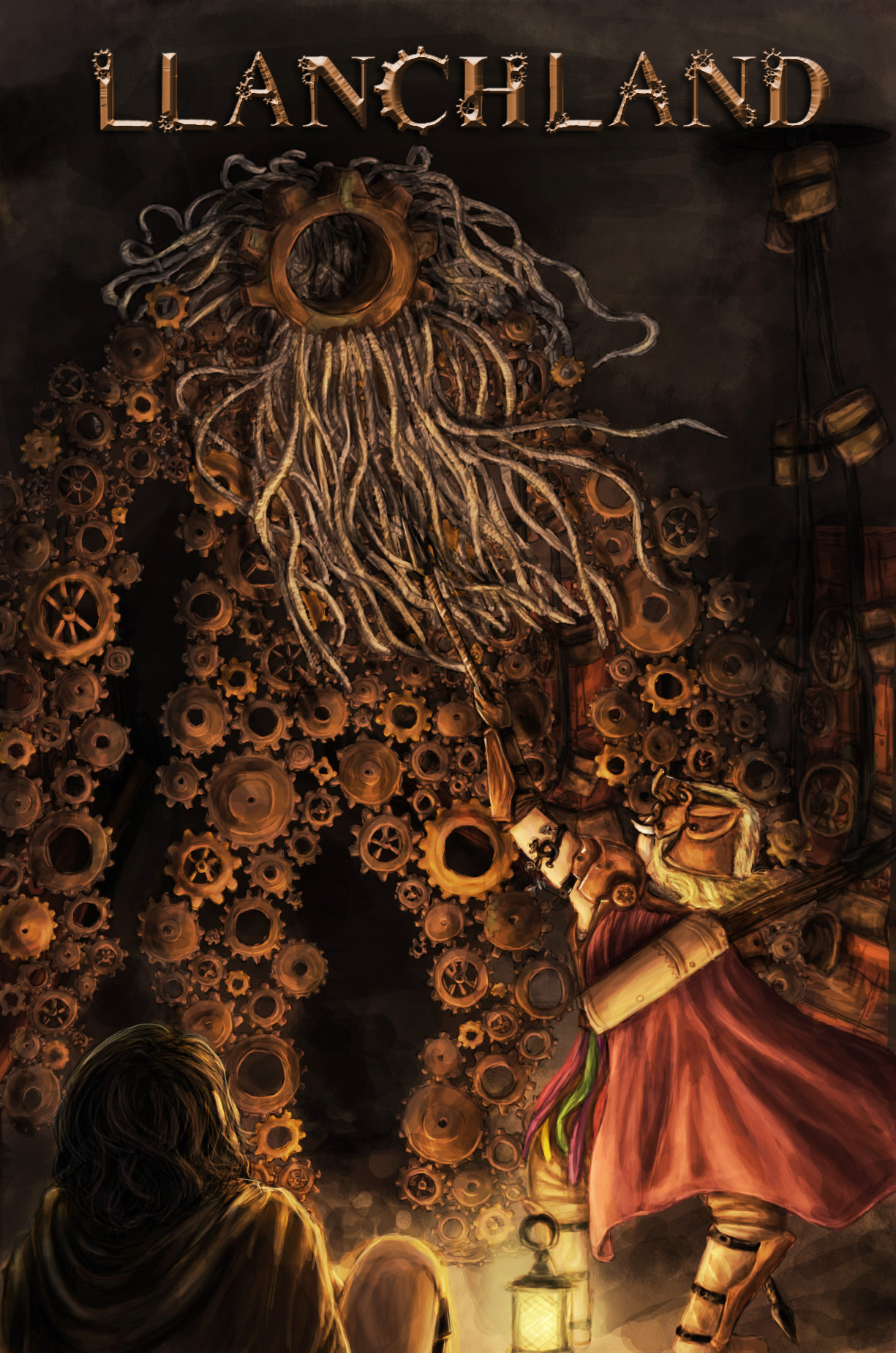
Talari calling wind spirits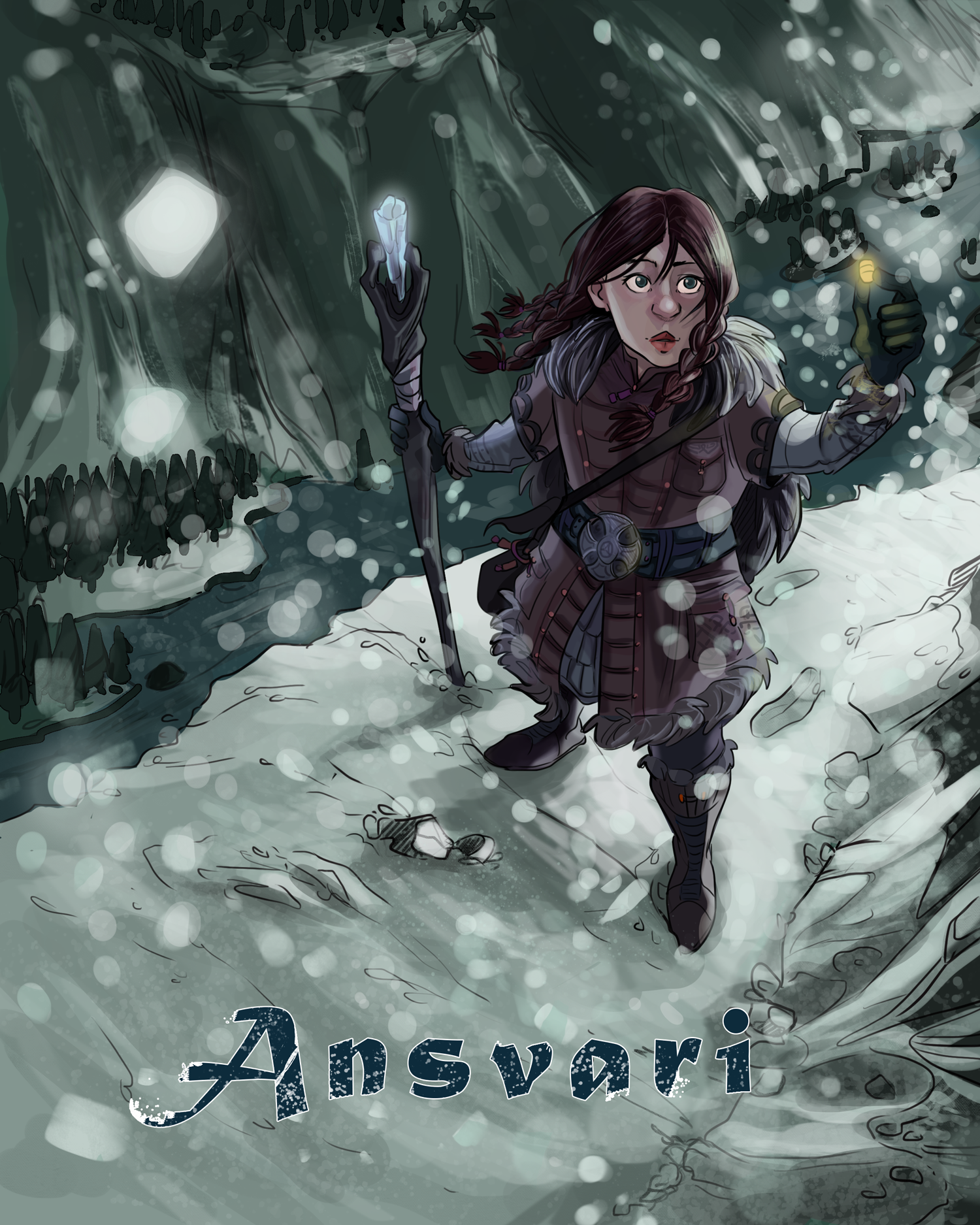
First update of the last month of both the contest and this campaign. We’ve still got quite a ways to go in order for this campaign to be successful, so hopefully we can pick up steam.
I’ve talked a bit about dwarves and elves with my previous updates, but since we’re now in October and rolling right towards Halloween I figured its time that I switch tracks a bit and start talking about a few of the "monsters" encountered in Exile, Magus. I should only have 4 more main updates(including this one) before the campaign ends, which works out well since there are 4 particularly terrors I wanted to cover: my jungle dragons, werewolves, frost giants, and ice dragons. I’ll be saving the dragons for the last two updates, so today I’ll be kicking things off with werewolves.
In the world of Exile, Magus there are of course the various high gods with their worldwide churches and whatnot, but they play no real part in this discussion. Its the opposite end of the divine spectrum which relates to werewolves, the small gods or nature spirits depending on your preference of terms. Back in the days before the Progenitors’ War and the subsequent first rise of both the Melexi and Thirosia empires, certain animal spirits sometimes decided to take physical form. These spirits would most often appear as the animals which most worshipped them, but due to the malleable nature of spirit-born flesh they could take other shapes as well, including that of humanoids such as elves, dwarves, and humans, or even a mix between the humanoid and beast forms. This led to the first lycanthropes(werewolves), now known more as spirit werewolves or werewolf progenitors.
These nature spirits were limited in their geographic region of influence, but within these regions they would often gain followers beyond their animal types, often being part of pantheons of small gods worshipped by the more nomadic of the humanoids. Some of the most favored of these humanoids were given the gift of lycanthropy or chosen as mates by the nature spirit. Any child born from such a pairing is born as a werewolf.
Any lycanthrope that is either originally a nature spirit itself, or is born as a lycanthrope, has no trouble controlling its actions so long as it is at peace with both its humanoid and beastly natures. Those who are transformed into a werewolf as a result of a nature spirit’s blessing or infected through a bite sometimes have trouble reconciling these two natures and thus struggle with control, the latter moreso than the former. In the Badlands south of Zaltruscas most werewolf packs fall under the control of the vampire lord Vargas, who can join his will with that of any lycanthrope touched so as to help them maintain control. (You can read a bit about the region known as the Badlands starting here, though Pentaz and Buscidia’s encounter with werewolves is detailed in currently unreleased chapters immediately following.)
There are other types as well such as ursanthorpes(werebears), scrofanthropes(wereboars), leothropes(werelions), and many others with much the same origins and history, though not necessarily the same geographical ranges. Most of the nature spirits themselves have ceased wandering in physical forms, returning to exist solely as spirits worshipped by their animals and nomadic humanoids with their shamans. The descendants of these curious spirits still exist today, however, and their populations have for the most part thrived as they form their own nomadic societies, breeding and living with one another. They tend to stay far from civilization lest the two worlds clash though, which has led to many of those living in the larger cities of Hanaen and Zaltruscas to think of these werebeasts as mere myths, if they even think of them at all.
Well, that’s all I’ve got for today. Hopefully you’ve enjoyed this bit of insight, and of course I’m also hoping many of you who have followed but not ordered yet will decide to pull the trigger before the end of this month. To all of you who have ordered, thank you so much. For any fellow D&D players/DMs I will have a stat block at the end. To everyone else, thanks for your time and support, and as always keep reading and enjoying!
For natural born lycanthropes or afflicted lycanthropes I feel the stats presented in the MM are close enough(though I tend to abhor the alignment choices), however there is nothing akin to my Werewolf Progenitors, so that is the stat block I’m giving everyone today. Hope you enjoy, and if you decide to try it out in your own game please give me feedback, I’d love to be able to tweak it to make it as good as possible.
Werewolf Progenitor Medium Fey (shapechanger), Neutral
Armor Class 13 in humanoid form; 14 (natural) in wolf or hybrid form
Hit Points 78 (12d8+24)
Speed 30’ (40’ in wolf or hybrid form)
Str 15(+2), Dex 13(+1), Con 14(+2), Int 10, Wis 14(+2), Cha 14(+2)
Saving Throws Wis+5, Cha+5
Skills Nature+6, Perception+5, Religion+3, Stealth+7
Damage Immunities Bludgeoning, Piercing, and Slashing from nonmagical attacks not made with silver weapons.
Senses passive Perception 15, Truesight
Languages Common, Sylvan
Challenge 7 (2,900 XP)
Innate Spellcasting The werewolf progenitor’s spellcasting ability is Charisma (spell save DC 15). The werewolf progenitor can innately cast the following spells, requiring no material components.
At Will: Druidcraft, Guidance, Resistance
3/day each: Conjure Animals (always either 4 dire wolves or 16 normal wolves), Healing Word (always for 5d4 points of healing, average 12), Pass Without Trace
1/day each: Freedom of Movement, Protection from Energy, Polymorph (if this is used on a willing humanoid target it can permanently change the target into a werewolf; when used in this way the progenitor cannot cast this spell again for 1 month)
1/week: Awaken (can have more than 1 animal under effects at a time, but can only be used on wolves or other beasts descended from wolves)
Keen Hearing and Smell Advantage on Wisdom(Perception) checks that rely on Hearing or Smell.
Magic Resistance Advantage on Saving Throws against spells and other magical effects.
Magic Weapons Bite and Claw attacks count as magical weapons.
Nature’s Blessing Gains its Charisma modifier to Armor Class in all forms.
Shapechanger The werewolf progenitor can use its action to polymorph into a humanoid or wolf-humanoid hybrid, or back into its natural form, which is a wolf. Its statistics, other than its AC, are the same in each form. Any equipment it is wearing or carrying isn’t transformed. It reverts to its true form if it dies.
Speak with Beasts The werewolf progenitor can speak with wolves and any beast related to wolves as if they shared a language.
Multiattack 2 bites(wolf form only); 2 spear attacks(humanoid form only); or 1 bite and 2 melee attacks with Claw or Spear(hybrid form only).
Bite(Wolf or Hybrid form only) Melee Weapon Attack: +5 to hit, reach 5’, one target. Hit: 6(1d8+2) piercing damage. If the target is a humanoid, then it must succeed on a DC 13 Constitution saving throw or become a werewolf.
Claw(Hybrid form only) Melee Weapon Attack: +5 to hit, reach 5’, one target. Hit: 7(2d4+2) slashing damage.
Spear(Humanoid or Hybrid form only) Melee or Ranged Weapon Attack: +5 to hit, reach 5’ or range 20’/60’, one target. Hit: 5(1d6+2) piercing damage, or 6(1d8+2) piercing damage if used with 2 hands to make a melee attack.
Tactics: They are a mostly peaceful sort, resorting to combat only when forced to do so to defend themselves or their allies/followers. They are usually accompanied by a pack of wolves, a band of humanoids, or some combination of the two. If combat ensues when they have no allies/followers present, they will take their first action to cast Conjure Animals, conjuring dire wolves if faced with 1-3 enemies, or normal wolves if faced with more than 3 enemies. Only once they have conjured these allies will a progenitor werewolf dive into melee combat, conjuring more wolves only if the fight is going very poorly for it(such as all the wolves first conjured being defeated). They have no fear of death since they know that their spirit form will eventually coalesce once more after death, allowing them resume their previous existence outside of life as a nature spirit.
Happy Wednesday everyone! Time for another update.
Wednesday update time!
Our progress continues to be slow, but with a little over a month to go I’m still hoping we can reach goal. Thanks to everyone who has already ordered as well as those of you who have recommended Magus to others.
Today I’ll move the journey forward a bit to Pentaz & Buscidia’s time on the peninsula known as The Blade where Pentaz spends a few months receiving a bit of formal education in his magicking at a small academy run by the head of a Wilder Elf community. You can read about that starting here in Chapter 31.
The Wilder Elves (pronounced will-der as in wilderness) are seen as savages by most of the more "civilised" elves in the far eastern elven nation of Lanadalaria, and even their less judgemental cousins in Hanaen sometimes regard them as a bit backwards. They live as nomads in the untamed wilds, living entirely off the land and flowing with the seasons. When they do build settlements it is only temporary structures, huts of vine, wicker, and fallen tree limbs which have seen no blade.
While they tend to avoid contact with those who do not live as they do, they are not hostile to outsiders and will often aid those they see in need, albeit secretly when possible. Like all elves they have innate magical talent, though all but their shamans and priestesses use this talent only for blending in and tracking game.
That’s all I’ve got for today’s update. As always thanks for reading, and I hope you enjoyed this bit of insight. For my fellow D&D players my prototype Wilder Elf racial option follows(as with the Dwarven options I presented this presumes you only gain what is listed below, not the standard PHB qualities as well).
Time to talk about the last of the Dwarven ethnic groups in the world of Exile, Magus. This particular group is for the most part not really a group at all. They could easily be seen as the most cosmopolitan of all the Dwarf types, having foregone the clustering into small communities of their own race in favor of direct coexistence with the other civilized races(mainly humans and elves). This has lead to a great diversity among them, to the point where they do not have any true ethnic identity, being typically referred to merely as Dwarves or Common Dwarves. Part of this diversity lies in the fact that so many of them had non-dwarf’s among their list of ancestors. Such an inclusion of human or (far more rarely) elf to their lineage is limited to 3 or more generations back since anything more recent would place them among the half-dwarves.
Such a lack of notable traits often leads to them being underestimated or taken for granted(especially by those who choose to refer to them as "Common" Dwarves), but they are remarkable as well. Unlike the other Dwarven groups, their approach to life has led to them being more capable of living with any race as well as adapted to a variety of tasks as opposed to filling only a few small niches. You can of course find examples of them focusing on typically Dwarven tasks such as smithing and warfare, but just as often you’ll find them filling other roles such as merchants, sailors, farmers, bakers, and so on. For an example of an exceptional Common Dwarf there is Karamos Daern in book 2 - Exile, Hunted. Admittedly he does fill a more traditional role as a master armorer and priest for the primary Dwarven God, Hatrien Quin, but he is exceptional nonetheless. You can have a brief encounter with him by reading this chapter in Exile, Hunted (which does have some spoilers for the current book, Exile, Magus, so be warned).
I’ll leave the description at that. Thanks to everyone who has ordered Exile, Magus already, and I hope that those of you who are following but haven’t ordered already will consider doing so. Even if you can’t order be sure to refer the book to others, if the book funds you can still win one of the available awards for being a top 10 referrer even if you haven’t ordered a copy for yourself.
That’s all I’ve got for this week (other than the Common Dwarf racial option for D&D 5th edition which I’ll be posting below for my fellow players/DM’s), so I’ll once again thank you all for your support and wish you enjoyable reading and whatever else you may desire.
First off, when I talked about the Sartval earlier this week I meant to link the chapters of Magus they appear in as well. They first appear in Chapter 10 and Pentaz’ full experience with them ranges from there to Chapter 17(a span that also covers his introduction to Buscidia). So if you want to read a bit more about that savage race of dwarves in action click the link above.
After a bit of a wall my campaign has started to pick up a little steam again, though we’ll need a great deal more if we’re going to make it so I’m hoping I can convince more of you who have followed but not ordered yet to do so. As stated at the beginning of the campaign, for every 25 readers I’ll post a new chapter. We’re only 8 more people away from the next chapter, and if we can hit 100 readers by 9/18 I’ll post 3 bonus chapters beyond those for each set of 25 people.
Moving on from the sales pitch though, I’m continuing my discussion of the different types of dwarves in my world. Next on the list are the Ansvari, their representative in Exile, Magus being Talari. She’s a bit of an intellectual, explorer, and a more knowledgeable magus than Pentaz, and she’s pictured below in the wonderful new art from Lho Brochoff. She doesn’t come in until the last act (quarter really) of the story, but if I get to post the bonus chapters mentioned above I will release 3 of those featuring her. She is one of the main characters in the sequel - Exile, Hunted, and most every Exile book to follow. I’ve linked this previously but I feel it deserves linking again in case you want to read an interaction from her childhood between Talari and her grandmother.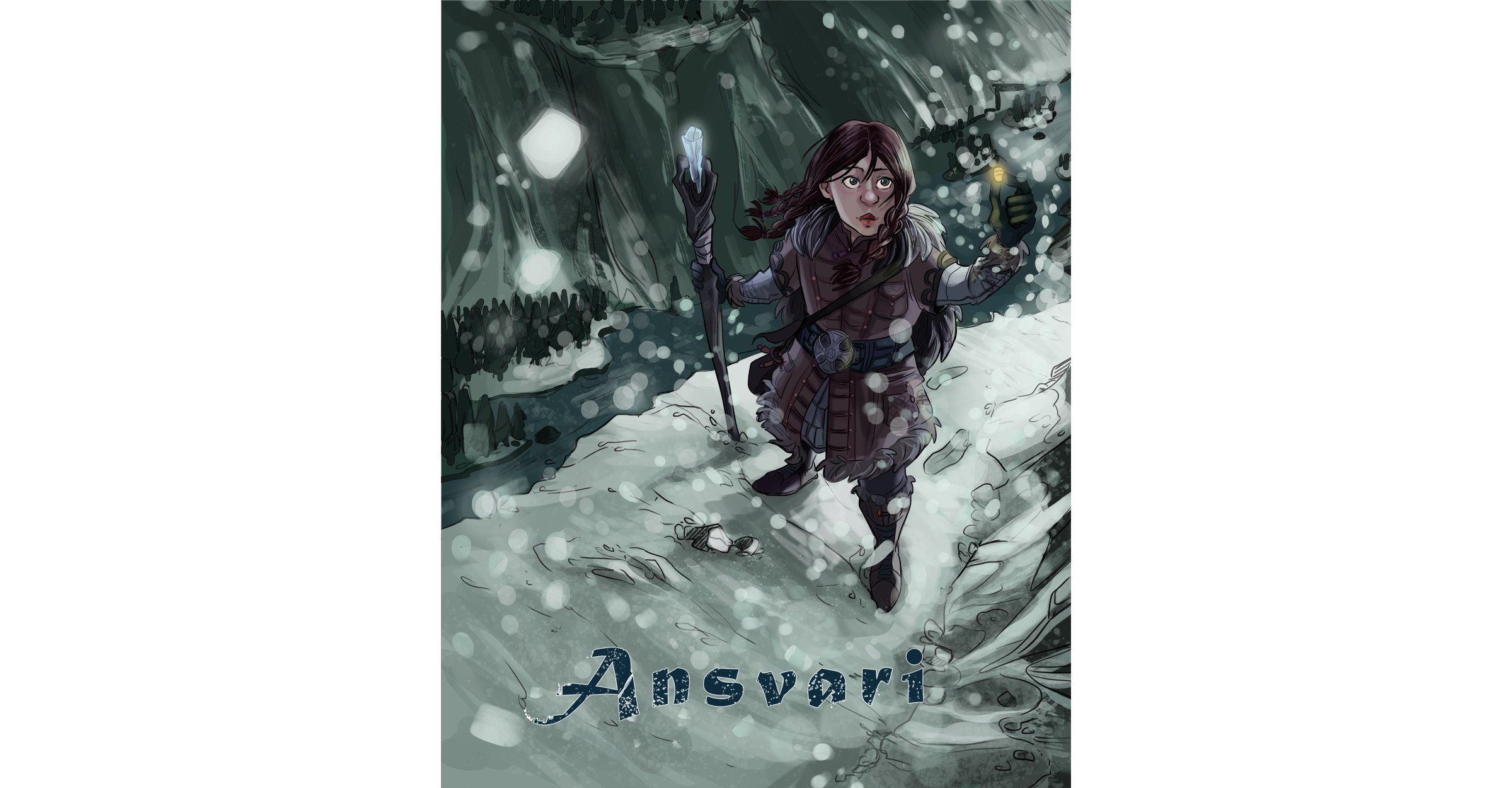
The Ansvari as a people are perhaps the least traditional Dwarves. They tend to live on wide open plains or sylvan glades, organized into loose tribal societies unofficial led by an elder and/or shaman(sometimes this is the same person).
They are a hunter/gatherer people who hold the spirits of nature, both elemental and otherwise, in deep regard. They don’t necessarily worship these spirits, but they always respect them. In truth they have much in common with the Wilder Elves, though they do put more importance on physical prowess than the Elves. Many Ansvari practice at least minor household magic, though not to the extent of the Elves. They also tend to be a curious people, though they usually limit their fields of study to those of the natural or magical world.
The bulk of the Ansvari tribes originally lived in a region of the Melexi empire now occupied by southern Zaltruscas and western Hanaen. As the Zaltruscan empire spread it demanded that the Ansvari cede their land and pledge their allegiance to the Empire. Most refused leading to a ruthless invasion by the Zaltruscans. In the conflict over half the resisting tribes were eradicated, prisoners executed in town squares or made to fight hopeless battles in the arenas to serve as examples.
Those tribes which survived only did so by fleeing east across the World’s Cleft River and taking refuge in the free Counties of Hanaen. Some of these tribes have found welcoming homes there, though a few such at Talari’s tribe, the Niajiry, are forced to live as little more than squatters in a county whose lord detests them.
I’ll leave my description of them at that, and as with the previous Dwarven subgroups I’ll post up a prototype of a 5th edition D&D racial option of them for anyone interested. As for the rest of you, I want to once again thank you for your time and support, and my sincere wish that you keep reading and enjoying.
Also, to those of you who have been reading these D&D options each time, I would like some input. A good friend of mine who has been playing in my D&D games for over a decade recently suggested I start taking advantage of the OGL to release a portion of Exile, Magus’ world for purchase online as a campaign setting. Would this be something you’d be interested in? Message me either here or through my Facebook page to let me know(or through Twitter - @thoasoold, but I’m bad about forgetting to check Twitter messages).
Today is that reviled day of the year in which I must officially acknowledge that I am one more year older than dirt. Boo! Hiss! If you feel inclined to give a birthday gift, then consider giving a gift to myself and yourself by placing a preorder. Okay, sales pitch over, now to get on to the interesting stuff.
Today I’ll be talking about the 2nd rarest of the Dwarven subspecies. The Zaltruscans and wanderers from other kingdoms refer to them as the Sartval, making this their most common name, but they have other names elsewhere - Elbegast in Hanaen, Yimeeri in the Frozen North. No one knows if the elves of Lanadalaria have their own name for them since the elves of the eastern nation don’t really talk with outsiders.
The Sartval are a savage race, their only interaction with outsiders taking the form of raids. They usually take as many prisoners as possible to use as slaves and eventually food. Just what caused their degradation into such a violent people with a preference for the meat of intelligent humanoids is a topic of much debate among scholars, debate which has failed to find any common conclusion.
Some theorize that they are exiles and/or descendants of exiles from Thierdenvolgenlunder who turned savage out of desperation over their banishment, though some argue that they were likely already such savages which is why they were exiled. Thierdenvolgenlunders would be quick to inform you that there have not been near enough exiles since their founding to account for the whole of the Sartval race, if Thierdenvolgenlunders even knew of their savage cousins’ existence that is. Others believe that the Sartval only became this way after the 2nd fall of the Melexi and Thirosian empires, their culture falling in parallel to those of goblins, orcs, giants, and various lesser known savage humanoids. Still others believe that they worship and/or have pledged their services to demons, dragons, debauched elemental lords, or whatever otherworldly bogeyman the speaker prefers and it is their pursuit of this worship/service that they commit vile acts.
The only things that are known are that Sartval are some of both the strongest and toughest of opponents in battle, and that they don’t speak to outsiders unless it is to bark commands.
That’s all I’ve got for the update section today, though I will be posting up my feeble attempt to make the Sartval a playable D&D 5th edition race. For those of you who don’t play D&D, I’ll close as always by saying thank you for your time and support. Keep reading and enjoying!
Another Wednesday, another map.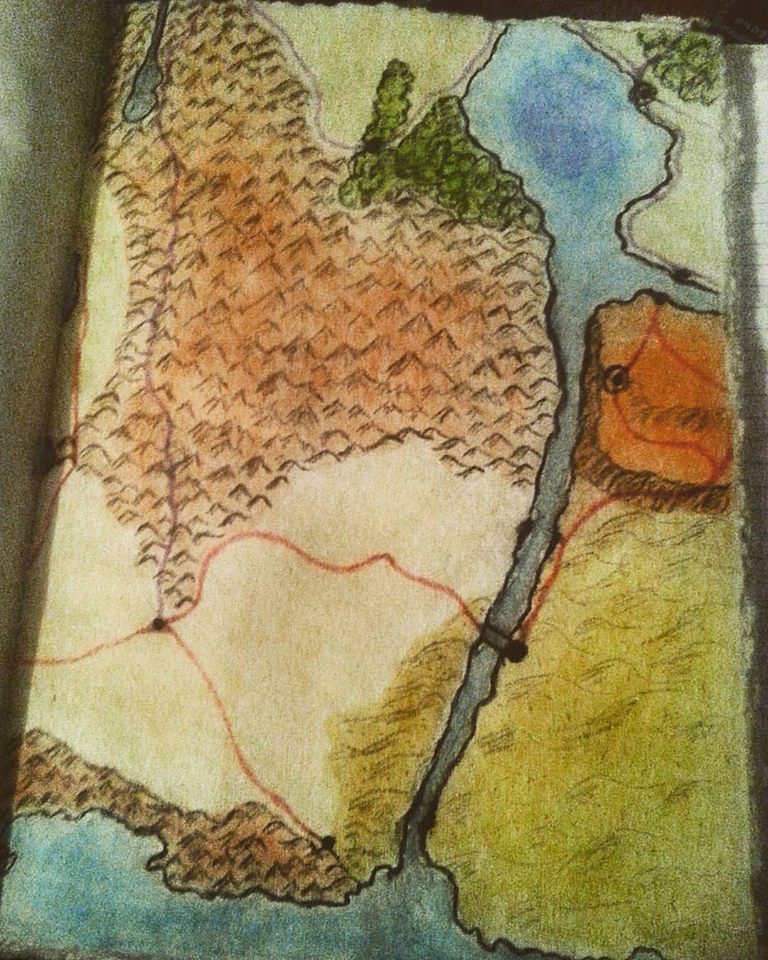
This one continues east from the previous map of the Blade and Badlands.
As one goes further north and east the horrors of the Badlands, only rarely crossing the borders formed by river at the east and mountains to the north. The mountains also mark the southernmost border of the Zaltruscan empire, though this fact is sometimes forgotten thanks to the presence of small outposts of Zaltruscan soldiers in those towns and cities of the Badlands most vital to the trade routes.
The eastern border of the Zaltruscan empire is formed by two branches of the World’s Cleft river springing out from the continent’s largest (and most unusual) lake - Lake Moiyrnthan. Pentaz’ travels take him no where near this during Magus, but it is seen in book 2 (Exile, Hunted) as well as book 3 (tentatively titled Exile, Seventh). If you want to read about the dwarven trios visit to the Lake I’ve posted it up on the Exile, Hunted page and you can read it here. It covers the unusual nature of both the Lake and World Cleft rivers as well as the myths surrounding them.
Across from the Lake is a small corner of Hanaen and its various counties. Crossing the river south from this you have plateaus upon which two more counties of Hanaen sit, only the westernmost of which is visible in this map. These plateaus descend southward into the great Kalthean desert which expands further east than is visible here, and also encroaches west back into the Badlands.
The massive bridge visible is a towering marvel of engineering built during the last days of the Melexi and Thirosian empires, and judging by the nature of the markings and decorations it was presumably a Melexi construction. The bridge’s immense size means that an army could easily fit on it, making it the most vulnerable point of defense against Zaltruscan invasion for modern day Hanaen. As a result there is a small military outpost of Hanaen to guard and man the bridge. A handful of Magi skilled in hydromancy are stationed with the soldiers here, their control over water allowing them to more rapidly use the bridge’s hydraulic mechanisms to raise the bridge to prevent an invasion should the Zaltruscan empire try to march an army across it.
That’s all I’ve got for today. We picked up in orders for a short bit, but have levelled off again, so I’m hoping I can get more orders coming in soon. We’re only 2 new readers away from me being able to release a new chapter, and if we reach that before the end of today(10/19) I’ll go ahead and release 2 new chapters. Also from this point until the end of the campaign I’ll be lowering the threshold for new chapters from 50 readers each to 20 readers each, hopefully I’ll get to share more of the story and at least hit Quill by the time this campaign ends.
Thanks to everyone for your support and time. Friday I’ll be talking a bit about dragons. Keep reading and enjoying! (Also, for my D&D people, I meant to post a stat block for a peculiar animal with last week’s map, but forgot to so you’ll be getting that below.)
This is an animal which Quelzhumi turns into during a pivotal moment of Part 7 - Graduation, and I’m ashamed to admit that I’ve not gotten around to coming up with a name for it. So for the time being we’ll just refer to it as Sloth-Bear-Anteater-thing. Quick description from Part 7 before I move on to the stats.
It hunches over him, but even in this stance it is a towering beast who’s head is a full yard above the lieutenant’s. This massive head is dominated by five almost comically oversized and lidless eyes which form a semicircle around the front. The eyes are flanked by large bat-like ears, and the entire face draws suddenly in and forward from these, reaching a length of nearly a yard and coming to a tapered point just barely larger than a man’s thumb. This snout is nearly all nose on the outside with multi-layered teeth and absurdly long tongue inside. The creature has no recognizable neck, only a widening of its frame drastically down from the ears, so that its shoulders are just a foot below the snout’s beginning but are over six feet wide.
The trunk and legs beneath have the shape and proportions commonly seen in a bear, but the arms are another matter entirely. They are monstrous protrusions crowding against the beast’s trunk where they sprout from the shoulders and are easily two feet thick. Their length is ill proportioned to the body, being nearly ten feet long before the claws protrude. These claws are the most terrifying features on the beast. Three spring from each otherwise featureless paw, with each an equally sized mixture of sabre and shovel head measuring a foot wide at their bases and tapering down along the two feet of their length.
The claws mentioned in the description are normally used to dig into ant-hills or other insect mounds(or termite infested trees), but there still pretty deadly weapons. The actual animals are rarely seen because they’re actually a bit cowardly, preferring to run from humans or other potential predators, but they will fight if forced to(though only a fool would force one to really). Now for stats.
Large Beast, Neutral
Armor Class: 10 (natural)
Hit Points: 92 (8d10+48)
Speed: 15’ / Burrow 5’
Str 20 (+5), Dex 5 (-3), Con 22 (+6), Int 2 (-4), Wis 12 (+1), Cha 6 (-2)
Senses: passive Perception 11, Tremorsense 10’
Challenge 3 (700 XP)
Relentless (recharges after a Short or Long Rest): if it takes 13 damage or less that would reduce it to 0 hit points, then it is reduced to 1 hit point instead.
Wounded Fury: while it has only 10 or fewer hit points, it has Advantage on Attack rolls. In addition, it deals an extra 2d6 ; damage to any target it hits with a melee attack while this is active.
Claw: melee weapon attack, +7 to hit (3d8 +5 piercing) ;